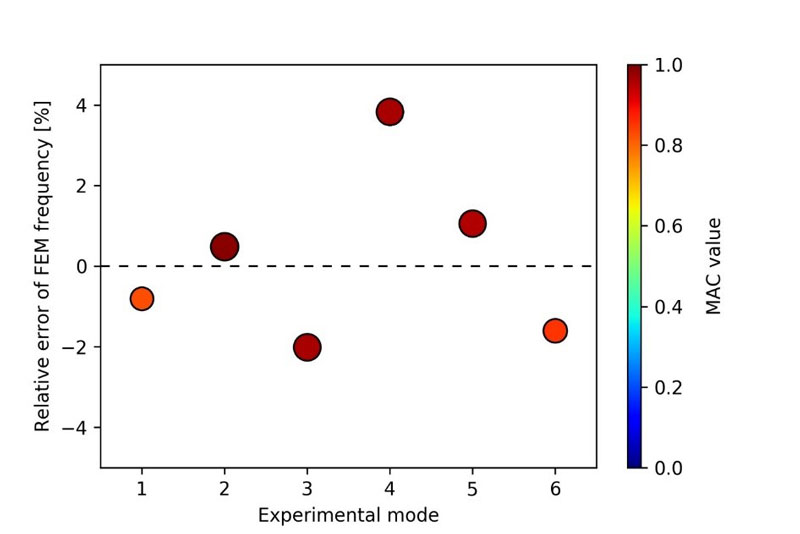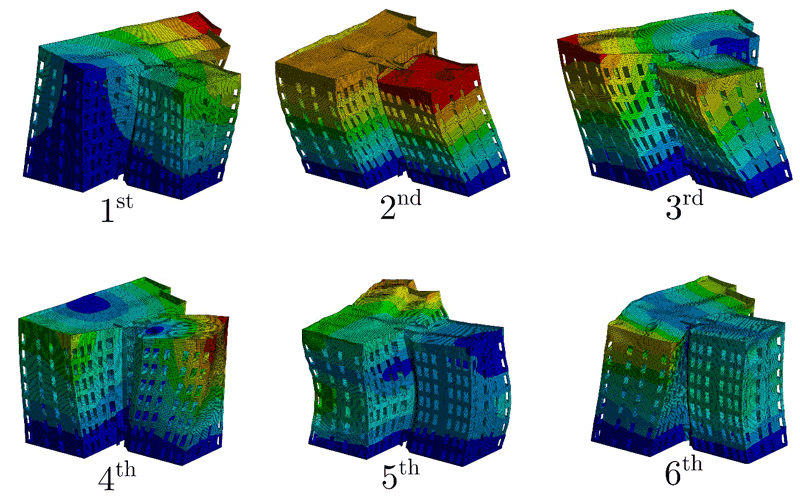by Blaž Kurent, Boštjan Brank (University of Ljubljana) and Aleksandar Pavic (University of Exeter)
As the number of tall wooden buildings increases, a good understanding of their dynamic behaviour becomes important. This calls for the collection of empirical data, namely in-situ measured dynamic responses, to enable the calibration of finite element models, the use of surrogates, Bayesian structural identification and uncertainty quantification.
The accuracy of the finite element (FE) models of modern tall timber buildings (TTBs) under service loading (e.g., wind) is poorly understood because of the lack of information and knowledge about stiffness and damping in TTBs. These structural properties are uncertain mainly because of the use of modern timber structural systems and various types of connections between the timber structural elements. Moreover, the wind-induced dynamic excitation is becoming the governing design criteria (besides the earthquake excitation in seismic areas) for determining size and shape of modern TTBs.
The world’s tallest timber building, Mjøstårnet in Norway, is 85.4 m high. For timber buildings of this height (and even lower) wind can generate vibrations that cause discomfort or annoyance to occupants due to the perceived horizontal swaying. Wind-induced vibrations can also generate undesirable peak acceleration levels. More experimental data on the dynamics of various types of TTBs under service loadings is required. The DynaTTB research project [L1], funded by the ForestValue research program [L2], performs on-site ambiental vibration tests and forced vibration tests (excited by shakers) on TTBs across Europe. The obtained data provides correlated modal properties (natural frequencies, mode shapes and damping ratios) as references for the design of future TTBs.
These experimental data are not only used to validate the best-engineering-judgement FE models for TTBs but also to improve them. During the calibration of the FE model, chosen (material) parameters of the model are tuned so that the computed response better represents the reality of TTBs’ dynamics. If the modelling error and the discretization error of the initial FE model are small, the results of the FE model calibration give insight into the more realistic values of the chosen parameters. To gain further insight into the parameter values, the Bayesian probabilistic framework is used. One of the methods is stochastic Monte Carlo sampling, which needs tens or hundreds of thousands of evaluations of the FE model. To reduce the computational time, a surrogate of the FE model may be built using machine learning tools. The simplest method for constructing a surrogate is the response surface method, where simple polynomial functions are fitted to the FE model results at certain design points. A more advanced method is generalised polynomial chaos expansion, where probability distributions of input parameters determine a set of orthogonal polynomials, evaluation points and their weights for fitting. Other advanced methods include kriging, neural networks, Bayesian networks and other techniques [1].
Let us briefly present the results of the calibration of the FE model of a seven-storey timber building located in Glasgow, UK, that is made entirely of cross-laminated timber (CLT) panels. Applying forced vibration modal testing [2], eight vibration modes were identified. The initial best-engineering-judgement FE model (with CLT described by the layered and orthotropic shell finite elements) reasonably matched the first four experimental modes, which is an acceptable model for predicting the structural dynamics in low frequencies. However, to get a better FE model that covers higher frequency response, a model calibration using a genetic algorithm was applied. After performing calibration of the initial finite element model with six material parameters being tuned, we obtained two additional matching modes and improved the accuracy of all computed natural frequencies significantly. Comparison of the computed natural frequencies and vibration modes with the experimental results is shown in Figure 1, and the first six mode shapes are presented in Figure 2. The abovementioned calibration process needed 485 evaluations of the FE model before it converged. We also tested the FE model calibration by using the surrogate, which was built with kriging on 89 evaluations of the finite element model, saving more than 80% of the computational time. For the presented example, the results of calibrations were comparable, but there is a concern about the reliability of surrogate models for more nonlinear systems that require more extensive model fitting and cross-validation. For this building, a Bayesian FE model calibration using a polynomial chaos expansion based surrogate model is in progress. The uncertainty quantification will also be performed.

Figure 1: Results obtained by the calibrated finite element model in comparison with the experimental data: relative error in frequency and modal assurance criterion (MAC) value.

Figure 2: First six mode shape of the seven-storey timber building in Glasgow, UK, made entirely of cross-laminated timber panels.
In conclusion, the finite element model calibration, the surrogate modelling, the Bayesian structural identification and the uncertainty quantification are being applied to some of Europe’s tallest timber buildings within the framework of the DynaTTB research programme [3], in order to get a better understanding of their dynamic behaviour and provide reference for the design of future TTBs.
Links:
[L1] https://www.dynattb.com/
[L2] https://forestvalue.org/
References:
[1] H. G. Matthies: “Uncertainty quantification with stochastic finite elements”, Encyclopedia of computational mechanics, 2004.
[2] W. K. Ao, A. Pavic: “FRF-based modal testing of sway modes using OCXO synchronised accelerometers for simultaneous force and response measurements”, EURODYN 2020 conference proceedings (in press).
[3] R. Abrahamsen et al.: “Dynamic response of tall timber buildings under service load – the DynaTTB research program”, EURODYN 2020 conference proceedings (in press).
Please contact:
Boštjan Brank, University of Ljubljana, Slovenia
Aleksandar Pavic, University of Exeter, UK











